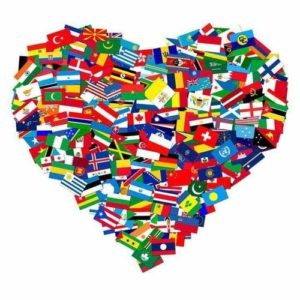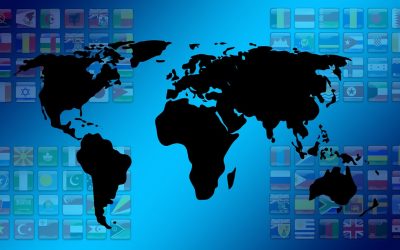Read our Translation Blog
Get the latest fun and facts from the language industry with our blog!
Need advice on website translation and localization?
Browse our ONLINE SHOP for ebooks on how to translate a website!
LingoStar’s Blog 
Welcome to LingoStar’s blog! On this page, you can find a lot of interesting and useful information about the translation industry. Explore topics on website translation and localization and how successful localization can influence your business to help your company grow and go global.
Language Blog Topics
On this blog, you can also learn about professional translators and interpreters, multilingual search engine optimization (SEO), the importance of socializing and networking and translators’ professional ethics. Quite often we write posts about the languages of the world, other cultures, and their traditions. Not only do translators convert texts from a source language to a target language, but they also help people communicate with each other, help establish international contacts, and are often prominent figures in the social, economic, and political life. Lastly, of course, we want you to have fun, so on our blog, you can find many posts that will entertain you and, hopefully, make you smile!
We hope you enjoy our blog and discover a lot of interesting things!
Traduzione ai tempi del Coronavirus: la comunicazione
Traduzione ai tempi del Coronavirus: come LingoStar può aiutarti con le traduzioni in questo periodo Prima di tutto ci auguriamo che voi, i vostri familiari e i vostri colleghi e amici stiate bene in questo momento di pandemia globale. Vogliamo informarvi che noi continuiamo a lavorare con la traduzione ai tempi del Coronavirus, poiché molti dei nostri traduttori ed editori lavorano a distanza “da casa”. D’altronde è questo il mondo della traduzione freelance. Pertanto, ci atteniamo alle raccomandazioni di distanziamento sociale e minimizziamo il rischio di contagio tra i nostri dipendenti e traduttori. Come può un’agenzia affrontare il Coronavirus con la traduzione? Siamo consapevoli del fatto che molte aziende in tutto il mondo abbiano bisogno di aggiornare i propri clienti, colleghi, dipendenti, partner commerciali e così via. Il nostro desiderio non è quello di trarre profitto da questa crisi, bensì di contribuire alla promozione dell’informazione. Per cui, sentitevi liberi di contattarci per qualsiasi esigenza di traduzione relativa alla comunicazione di COVID-19. Che si tratti di una traduzione o di un voice-over, saremo lieti di aiutarvi a diffondere il vostro messaggio multilingue in spagnolo, francese, cinese, italiano, coreano, tedesco, farsi e altro ancora. Nelle ultime due settimane, abbiamo già tradotto messaggi e annunci aziendali per alcuni dei nostri clienti. Traduzione ai tempi del Coronavirus: chiedi il nostro aiuto Sappiamo che i vostri messaggi in questi tempi dovranno raggiungere più persone molto velocemente. Pertanto, lavoreremo 24 ore su 24 per assicurarci che le vostre esigenze di traduzione siano soddisfatte. In questo duro momento, per le traduzioni relative a COVID-19, il sovrapprezzo dell’urgenza, se richiesta, non verrà accreditato. Naturalmente, come di consueto,... read moreCOVID-19 Übersetzung: Hilfe bei mehrsprachiger Kommunikation
COVID-19 und wie LingoStar Ihnen mit Ihrer COVID-19 Übersetzung helfen kann Als Erstes hoffen wir, dass es Ihnen, Ihrer Familie und Ihren Kollegen in diesen schwierigen Zeiten gut geht. Da der Coronavirus, auch COVID-19 genannt, sich immer weiter in Kanada ausbreitet, beachten Sie bitte die allgemeinen Informationen der kanadischen Regierung, um Ihre Sicherheit zu gewährleisten. Wir möchten Sie wissen lassen, dass wir in dieser Zeit immer noch aktiv sind, da viele unserer Übersetzer und Redakteure traditionell von “zu Hause” aus arbeiten. So sind wir normalerweise in der Welt der freiberuflichen Übersetzung tätig. Somit halten wir uns bereits jetzt an die Empfehlungen zur Sozialen Distanzierung und minimieren das Infektionsrisiko bei unseren Mitarbeitern und Übersetzern. Daher stehen wir für alle Anfragen im Bezug auf eine COVID-19 Übersetzung zur Verfügung. Wie kann eine Übersetzungsagentur dabei helfen COVID-19 zu bekämpfen? Wir verstehen, dass viele Unternehmen auf der ganzen Welt mit ihren Kunden, Kollegen, Angestellten, Geschäftspartnern usw. kommunizieren müssen. Unser Wunsch ist es nicht von dieser Situation zu profitieren, sondern Informationsweiterleitung zu fördern. Zögern Sie also nicht, sich mit jeglichem Übersetzungsbedarf im Zusammenhang mit dem COVID-19 an uns zu wenden. Ob es sich um eine Übersetzung oder ein Voice-Over handelt, wir helfen Ihnen gerne dabei, Ihre mehrsprachigen Mitteilungen in Spanisch, Französisch, Chinesisch, Italienisch, Koreanisch, Englisch, Farsi und mehr zu verbreiten. In den letzten zwei Wochen haben wir schon Firmenmitteilungen und -ankündigungen für einige unserer Kunden übersetzt. Kontaktieren Sie uns bezüglich Ihrer COVID-19 Übersetzung Wir wissen, dass Ihre Botschaften im Moment viele Menschen schnell erreichen müssen. Daher arbeiten wir rund um die Uhr um sicherzustellen, dass Ihr Übersetzungsbedarf erfüllt wird. Zudem werden wir in dieser... read moreTranslation services in Vancouver? You can trust LingoStar.
We are a guarantee for your translation services in Vancouver and worldwide. Looking for a multicultural and multilingual translation agency? LingoStar is your guaranteed solution. Why? Firstly, we are based and offer our translation services in Vancouver. Secondly, we can assist you round the clock thanks to our worldwide team of professional freelance translators. Lastly, we work in over 100 languages in a wide range of fields of specialization covering not only translation but also interpreting, proofreading, typesetting, localization, language tutoring and more! Who are we? LingoStar was established in 2004 and has been growing ever since! Our network of professional freelance translators spans five continents. As a result, we are available to offer you impeccable translation services worldwide. Our team consists of in-house and freelance translators as well as marketing professionals, project managers and many more language expert enthusiasts! What services can we offer you? Professional translators carry out our translations. They are native speakers of to name but a few: Dutch, German, Spanish (European Spanish and Latin American Spanish), Portuguese (European Portuguese and Brazilian Portuguese), Italian, and French (European French and Canadian French), Chinese (Traditional and Simplified), Japanese, Korean and more! We specialize in fields such as commercial, audiovisual, legal, marketing, and website content translations. We can provide services like interpreting, transcription, voice-over, dubbing and subtitling. How LingoStar can help you We offer the best translation service in Vancouver. Our project managers analyze your requests, ask professionals to complete the translations, and proofread them. We deliver them to you by the established due date. We are at your service. If you need more information, call us today on... read moreEffective Communication – Discover what it is with LingoStar!
Effective Communication: what is it? Effective communication consists of information that is well shared. It could be verbal, non-verbal, written, etc. One considers emotions, the ability to speak, engaged listening, etc. What makes effective communication tricky? Semantic barriers. The misunderstanding between the sender and the receiver. They are due to the different meanings they give to words. People use symbols or words that can mean more than one thing. Or, also, a technical jargon. Organizational barriers. Obstacles in the flow of information. For example: among parents and children, teachers and students. And also employers and employees, etc. Emotional barriers. Lack of attention and premature evaluation. But also poor retention and distrust. Firstly, people are interested in other things and do not listen with attention. Secondly, they jump to conclusions without considering all the information. Thirdly, the brain retains just the information that could be helpful in the future and nothing more. The sender and receiver have to trust each other. If not, the communication will be meaningless. And there are also personal communication barriers… Personal barriers. Life experiences, attitudes, emotions, and behaviours. These lead to a lack of listening, attention, knowledge, and vocabulary. The receiver listens with his ears but not with his mind. He hears only what he wants to. The sender and receiver do not have the same knowledge of a specific topic. The sender uses words that are difficult to understand. We should also mention barriers related to disability. For example, how to make a visual message accessible to the visually impaired? And how to make an oral message accessible to the hard of hearing? These... read moreT-glottalization: what is it and where has the letter /t/ gone?
T-glottalization or t-glottaling? T-glottalization: the misperception of the letter /t/or T-glottaling, is when the sound of the consonant /t/ changes into a glottal stop. A glottal stop is literally the spot to take a break when you are supposed to produce a sound, in this case, the ‘t’ sound. It just stops in your throat. It’s like when you are about to say something and someone cuts you off. This pronunciation of the /t/ occurs in many varieties of English. Take an example of writ’t’en, Bri’t’ain, or impor’t’ant. Before pronouncing the /t/, there is a sudden pause and then you go for /ː(ə)n/ː(ə)nt/. To find out more about what is a glottal /t/ sound and how it is used in English, check out this informational video on glottal /t/ sound in American English. Using this video, practice your American pronunciation and speak like a native! The glottal stop or T-glottalization The glottal stop can actually replace a consonant so, for example, the letter /t/. Therefore we call it “T-glottalization”: the misperception of the /t/. Check out the pronunciation of ‘button, cotton or kitten’ and other words in the video above. Certain studies such as the one of Jeremy Obrien from UCSC Linguistics Research Center showed that the place of articulation of the letter /t/ could be confused with one of the glottal stops. The letter /t/ is part of the stop consonants which are /t/, /p/, /k/ but the /t/ is the only consonant that can get dropped for a glottal stop. It rarely happens with the /p/ and the /k/. In general, the glottal stop occurs especially on... read moreValentine’s Day Traditions Around the World. How people celebrate it?
How many Valentine’s Traditions do you know? Valentine’s Day, on February 14th, is the second-largest card-giving day of the year, just after Christmas! On that note, if you forgot to read about Christmas traditions, take a look here! As for Valentine’s, people celebrate it in many different ways around the world. How people celebrate lovers’ day? Let’s check it out! The History of Valentine’s Day Around the world, this day is celebrated in the name of Saint Valentine. But who was he? Saint Valentine lived during the 3rd century in Rome, under emperor Claudius II. Claudius thought that single men were better soldiers than married ones so he outlawed marriage for young soldiers. Valentine thought it was an injustice and started to perform secret wedding ceremonies for people upon request. When the emperor found out, he ordered his murder. Gradually, word spread about Valentine and couples all over the world started celebrating Valentine’s day as a day of love. Valentine’s Day in Argentina Argentinians don’t celebrate Valentine’s Day in February but during “the week of sweetness” in July. During this week, lovers exchange kisses and receive chocolates every day! We at LingoStar believe that exceptions and differences make the world an extraordinary place to live in! Don’t you? Lovers’ Day in France France is considered the country where Valentine’s Day originated, and the first Valentine’s Day card was sent. Moreover, on this day, people decorated yards, trees and homes with love cards, roses and proposals for marriage. Unquestionably, this is probably the most romantic tradition in the world! Lovers’ Day in South Korea In South Korea, people celebrate the day... read moreLearn a Foreign Language Another Way: In Your Native Country
How to learn a foreign language? Usually you learn your first foreign language in primary school. In many countries around the world, English is the second language to learn. When you learn a new language, it means starting all over with the basics, and then trying to put everything together to make sense. Some say that children learn faster. According to an article on the website “Testbig“, the capacity that children have to learn quickly is considered an advantage in learning a foreign language. That could be the reason why we start learning very young. How to learn a foreign language at home When it comes to improving the learning of a foreign language, there is one option that is obvious: go abroad. But we all know that traveling or studying abroad is not affordable for everyone. Even though many universities offer scholarships, not all students are eligible. However, if you are able to study abroad, it can be a valuable experience. Check out this student article “Study in Vancouver” on the LingoStar website. But if you are not able to travel, there are other alternatives. First, being familiar with the sound of a language helps a lot. The more you hear it, the more you will understand it and be comfortable with it. Your pronunciation will improve and it will be easier to speak by becoming familiar with the accent and vocabulary. Secondly, audiovisual works, music or even a friendship with a foreigner are some of the best ways to master a fluid accent, understand the different nuances of a language, and learn different local accents. Convinced to... read moreAudiovisual Translation Nowadays: Another Perception of Translation
What is Audiovisual Translation Audiovisual translation, also known as ‘AVT’, is the translation for audiovisual works. This is as a series of related images accompanied by sounds and projected on various devices. Translation for audiovisual works has its own rules. It requires a special method of translation. Many new tools and apps have been created for this purpose. You can also read about these new developments in technology in our post on automatic translation. Issues with Audiovisual Translation Even though new technologies have evolved tremendously in this field, the interesting part about AVT translation is the language register. This register represents the tone and style of writing and it can be formal or informal. Also, different situations and people call for different registers. Translators specializing in audiovisual translation usually work with many different registers. In this field, it is not a question of translating words for words. It is necessary to retransmit the feelings of a script. Why? Because the source text and the final written translation must have the same effect. For example, cultural research is very important in order to translate an onomatopeia. ‘Meta magazine’ points out these problems with AVT: the synchronization between image and sound from one language to another, especially in voice-overs; the distinction between oral and written language. AVT is Evolving The demand for audiovisual translation is growing worldwide. At LingoStar we have completed numerous audiovisual translations, including voice-overs in Chinese Mandarin, Cantonese, Japanese, French, European and Latin American Spanish, German, Czech, and others. A decade ago, English was the main language used for all AVT translations. But thanks to companies such as... read moreSome New Year’s traditions from Cultures Around the World
How many New Year’s traditions do you know? Obviously, we are sure you know at least two or three New Year’s traditions from different cultures. Alternatively, we would like to share with you some of the most unique New Year’s traditions that we know from around the world. And, if it wasn’t enough, take a look at this amazing page containing 50 New Year’s Traditions from around the world! Canada Firstly, we are going to mention something about Canada. A tradition started in 1920 involves jumping into the freezing waters of English Bay on New Year’s Day. This is called the Polar Bear Swim. Do you dare to? 😉 Italy In Italy, it’s a very strong New Year’s tradition to spend New Year’s Eve with friends or family, at home for dinner or at parties. In fact, they usually eat lentils for good luck, together with zampone, a typical salami from Emilia-Romagna. After that, they countdown to midnight and toast with sparkling wine. Moreover, wearing red underwear is thought to bring love, prosperity and good luck! Czech Republic The Czechs believe that, as a New Year’s tradition, it is possible to predict what is going to happen in the coming year by cutting an apple in half and looking at the shape of its core. New Year’s Traditions in Argentina and Bolivia Argentinians believe that wearing pink underwear will attract love in the new year. Moreover, eating beans will help people to keep their current job or find a better one. Different from Argentinians and Italians, Bolivians believe that wearing yellow underwear will increase their fortune for the new year.... read moreChristmas traditions of the world: how many are there?
How many Christmas traditions exist in the world? Is it possible to know all the Christmas traditions of the world? We know it’s almost impossible, but we will try to tell you about some. And, if you want to know more, please take a look at this interesting article about Christmas traditions all around the world. Christmas traditions in Canada Canadians love to adorn their houses with lights and decorations. This nation is particularly fond of Santa Claus. This might be because his home in the North Pole is so close to Canada! The Santa Claus Parade in Toronto is one of the oldest and largest Santa parades in the world: more than 2500 people take part in it! The traditional Canadian Christmas meal is roast turkey with vegetables and potatoes. But, Canada is a very large country, full of people with many different cultural backgrounds. For example, the Ukrainian community in Canada is one of the largest in the world, and they will have their traditional 12-dish meal for Christmas. Christmas traditions in Italy Italians love the Nativity scene. In fact, St. Francis, a Saint from Italy, made it very popular in 1223. It can be recreated in several ways: using handmade figures (waterfalls, food, animals, people), with a background made of paper or painted glass. Additionally, the set is different: you can use a hollowed-out wooden trunk, a “trullo” (a typical building of the South of Italy made with dry stone) or within the same dry stones one finds in Matera. Every year in Matera, the locals put on a play that recounts the story of the... read moreAutomatic translation: what it means and what it represents
What is automatic translation? “Automatic translation” means substituting words from one language to another. It is software that translates a text in a very short time with little human effort. How does it work? It is usually (and hopefully) based on corpora. Words are translated automatically because of other words nearby. However, because a machine can’t think, it can’t give a perfect translation. It lacks context and meaning. For more on this, take a look at our blog post about Common Mistranslations. What does automatic translation mean for “human” translators? There are two opinions on the subject: It means that a machine with no faculty of thought could take the translator’s place. The machine works rapidly. On the other hand, using a machine could be useful when the topic is technical. Likewise, when one just wants to understand the general meaning of a text. This can help the translator in post-production. That is to say, the translator can edit and proofread the machine-translated text until it reads naturally. Does automatic translation represent a real threat? The answer is: it depends. If a machine translation is trained in a specific field, the resulting technical translation could be useful. It represents a threat if the translator is afraid to be replaced. However, it could also be an opportunity for the translator to save time by working with the text post-production. However, if one wants to translate a literary text, the machine translation will fail. Why? Because in a literary text, you will find metaphors, allegories, hidden meanings and more. A machine cannot identify these figures of style and will therefore produce a... read moreGreta Thunberg and the environment: let’s opens our eyes to reality.
How languages and Greta Thunberg are connected to the environment. News items about climate change, Greta Thunberg and the environment bombard us. Something is changing all over the world. But what’s really happening? And who is this girl speaking to our state representatives? Her name is Greta Thunberg. Who is Greta Thunberg? Greta Thunberg is a 16-year-old Swedish girl. People consider her a young influencer for the environment. Last year she wanted to meet politicians. In fact, she started to spend her days in front of the Swedish parliament. She has organized strikes and founded a movement called Friday for Future. Greta took part in several debates about the environment. She was present at several conferences: firstly, the Katowice Climate Change Conference, which made her famous; secondly, the World Economic Forum in Switzerland; thirdly, the meeting at the European Parliament. She also went to the Senate of the Italian Republic (where she met Pope Francis); World Earth Day in London; and finally, to the United States Congress in Washington. She wants to share her message: “We have wasted too much time and risk having no future.” What is happening in our World? The effects of global climate change are clear. Glaciers are disappearing and the temperature of the globe is rising. In the long term, the seasons will no longer exist. Besides, precipitation will increase. There will be more aridity and stronger hurricanes. Species are becoming extinct. What we can do for the environment? As Greta Thunberg says, we should be activists for the environment. We should share awareness in every possible way: in English, Spanish, Chinese, using images,... read moreFreelance translator daily organization: LingoStar can help you get it right
How organized are you? A freelance translator’s daily workload Those of you who work from home know that establishing a good daily routine can be a challenge. There is no place for tiredness or boredom in a freelance translator’s day. You must manage your time wisely and can only count on yourself to complete the wide variety of tasks you have to juggle and to get the work done. A freelance translator spends hours in front of a computer working with texts or visuals, using various technical software programs and dictionaries. For example, multiple projects, lengthy documents in several languages, tight deadlines, meticulous attention to detail, all these are part of a typical day’s work. Unfortunately, if not carefully managed, these aspects can lead to a problematic sedentary lifestyle. Indeed, this in turn comes with its own health risks: reduced mobility, lethargy, weight gain, back pain, cardiovascular issues, headaches, eyesight problems, low mood. It’s easy to see the negative impact a sedentary lifestyle in front of a computer can have on your health. Therefore putting time aside for your own personal wellbeing is crucial. On top of all this, you may have to continue dealing with all the typical household duties – such as the school run, shopping, cooking, helping with the kids’ homework, taking them to their respective activities, doing the laundry, etc. – but combined with your own daily workload, it can very quickly get out of hand. It’s very common for a freelance translator to feel overwhelmed. We hope our top tips below will help you with your daily organization to achieve a better work-life balance!... read morePublic Speaking
What is Public Speaking? Public Speaking in Vancouver or in any part of the world is the way by which we connect with a live audience. We are living in a world where we need to prove ourselves by our actions. Some people are really extroverted and some are introverted. Also, some people have good communication skills while others are nervous when speaking in public. Communication is the very first impression a person makes on another person. At the same time, public speaking plays an important role in the professional or business environment. All successful job interviews are based on the communication skills and confidence of the interviewee. Ways to Overcome a Fear of Public Speaking Know your topic and audience: Before going in for a presentation or speech, it is important for the individual to know well what they are speaking of and who they are speaking to. Knowing this will help the speaker to present with confidence. Good posture: To look confident, it is important to have good posture while speaking to a group of people. It shows that you have perfect knowledge of the topic and are comfortable with the audience. Relate with personal life: It is always beneficial when you relate the topic to your personal life. In that way, you can express your words or feelings in a convincing manner. Begin and end strong: Always make sure that your introduction and conclusion have a strong impact on the audience. As a result, the audience will understand the topic from the very beginning and leave with a good impression.Add visual aids: While doing public speaking, visual aids play... read moreSuperstitions in India: the fear of the unknown
What is a Superstition? A superstition is a belief that is considered supernatural or irrational. Over the years there have been many superstitions that have developed and some are still present. In every country there are superstitions but they may come in different forms. For example, they can be related to a number, day, colour, animal, etc. Superstitions in India: In India there are a lot of superstitions which are believed as supernatural. So here are some of the most interesting ones: Shaking of legs: If a person’s legs shake continuously, they will be left with less wealth. Washing hair on Thursday: Thursday is considered a bad day for washing your hair. The reason again is fear of losing wealth. If you see a garbage truck: If you see a truck full of garbage before leaving your home, it means that your day will pass very well. However, if you see a garbage truck that is empty before leaving your home, it is considered bad and unlucky. More superstitions in India: Colour (White and Black): The colours white and black are not considered lucky for a new bride. She cannot wear these colours for a few months because it is considered a threat on their new relationship. Whereas, in developed countries, it is tradition for the bride to dress in a white gown for the wedding. Sneeze: If you are about to leave from your home for work, and someone sneezes, it is thought to be fear of the unknown. Something will go wrong on the way or the task will not be completed. Perfumes and colognes (fancy and... read moreTranslation Blog and News
LingoStar has been a language services provider in Canada, the USA, and Europe for more than a decade. We are proud to say that we cooperate with professional translators, interpreters, and other language specialists worldwide and work with over 100 language pairs. If you are looking for a reliable translation company, contact LingoStar! We are always ready to help you with your projects and documentation. Get a free quote online.













